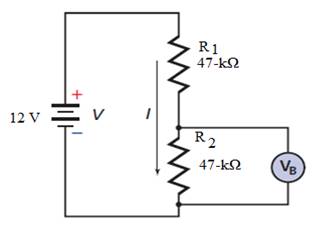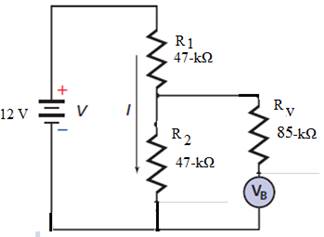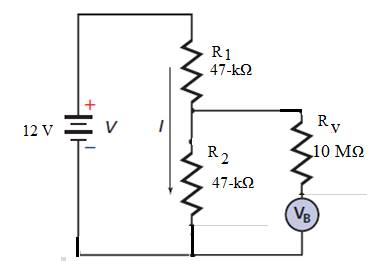
Concept explainers
(a)
The output across the resistance R2 using an ideal voltmeter.
(a)
Answer to Problem 91A
The output voltage across R2 is
Explanation of Solution
Given:
A voltage divider circuit consists of two resistors of value,
Formula Used:
The voltage across a resistor in a potential divider circuit with a supply voltage V is given by,
Calculation:
Consider the potential divider circuit shown in Figure 1. Here, the supply voltage is 12-V and the two resistors have 47-kΩ.

Figure 1
In the given case, the voltmeter is ideal and hence has no resistance. Thus, it measures the voltage across
Conclusion:
The voltage across R2 as measured using an ideal voltmeter is 6 V.
(b)
The output across the resistance R2 using an ideal voltmeter.
(b)
Answer to Problem 91A
The output voltage across R2is
Explanation of Solution
Given:
A voltage divider circuit consists of two resistors of value,
Formula Used:
The voltage across a resistor in a potential divider circuit with a supply voltage V is given by,
Calculation:
Consider the potential divider circuit shown in Figure 2. Here, the supply voltage is 12-V and the two resistors have 47-kΩ. The voltmeter connected across R2 is having a resistance of 85 kΩ.

Figure 2
In the given case, the voltmeter is having a resistance and this appears in parallel with
Now, the voltage measured by the voltmeter is given by
Conclusion:
The voltage across R2 as measured using a voltmeter of given resistance is 4.69 V.
(b)
The output across the resistance R2 .
(b)
Answer to Problem 91A
The output voltage across R2 is
Explanation of Solution
Given:
A voltage divider circuit consists of two resistors of value,
Formula Used:
The voltage across a resistor in a potential divider circuit with a supply voltage V is given by,
Calculation:
Consider the potential divider circuit shown in Figure 2. Here, the supply voltage is 12-V and the two resistors have 47-kΩ. The voltmeter connected across R2 is having a resistance of 10 M?.

Figure 3
In the given case, the voltmeter is having a resistance and this appears in parallel with
Now, the voltage measured by the voltmeter is given by
Conclusion:
The voltage across R2 as measured using a voltmeter of given resistance is 5.99 V. It can be observed that as the resistance of the voltmeter is made higher, the measured voltage value is close to ideal case.
Chapter 23 Solutions
Glencoe Physics: Principles and Problems, Student Edition
Additional Science Textbook Solutions
Laboratory Experiments in Microbiology (12th Edition) (What's New in Microbiology)
Campbell Biology (11th Edition)
Introductory Chemistry (6th Edition)
Campbell Biology in Focus (2nd Edition)
Chemistry: The Central Science (14th Edition)
Cosmic Perspective Fundamentals
- No chatgpt pls will upvotearrow_forwardThe force of the quadriceps (Fq) and force of the patellar tendon (Fp) is identical (i.e., 1000 N each). In the figure below angle in blue is Θ and the in green is half Θ (i.e., Θ/2). A) Calculate the patellar reaction force (i.e., R resultant vector is the sum of the horizontal component of the quadriceps and patellar tendon force) at the following joint angles: you need to provide a diagram showing the vector and its components for each part. a1) Θ = 160 degrees, a2) Θ = 90 degrees. NOTE: USE ONLY TRIGNOMETRIC FUNCTIONS (SIN/TAN/COS, NO LAW OF COSINES, NO COMPLICATED ALGEBRAIC EQUATIONS OR ANYTHING ELSE, ETC. Question A has 2 parts!arrow_forwardNo chatgpt pls will upvotearrow_forward
- No chatgpt pls will upvotearrow_forwardSolve and answer the question correctly please. Thank you!!arrow_forward་ The position of a particle is described by r = (300e 0.5t) mm and 0 = (0.3t²) rad, where t is in seconds. Part A Determine the magnitude of the particle's velocity at the instant t = 1.5 s. Express your answer to three significant figures and include the appropriate units. v = Value Submit Request Answer Part B ? Units Determine the magnitude of the particle's acceleration at the instant t = 1.5 s. Express your answer to three significant figures and include the appropriate units. a = Value A ? Unitsarrow_forward
- Solve and answer the question correctly please. Thank you!!arrow_forwardSolve and answer the question correctly please. Thank you!!arrow_forwardA spiral transition curve is used on railroads to connect a straight portion of the track with a curved portion. (Figure 1) Part A v = v₁ft/s 600 ft y = (106) x³ If the spiral is defined by the equation y = (106)³, where x and y are in feet, determine the magnitude of the acceleration of a train engine moving with a constant speed of v₁ = 30 ft/s when it is at point x = 600 ft. Express your answer to three significant figures and include the appropriate units. ? a = Value Unitsarrow_forward
 College PhysicsPhysicsISBN:9781305952300Author:Raymond A. Serway, Chris VuillePublisher:Cengage Learning
College PhysicsPhysicsISBN:9781305952300Author:Raymond A. Serway, Chris VuillePublisher:Cengage Learning University Physics (14th Edition)PhysicsISBN:9780133969290Author:Hugh D. Young, Roger A. FreedmanPublisher:PEARSON
University Physics (14th Edition)PhysicsISBN:9780133969290Author:Hugh D. Young, Roger A. FreedmanPublisher:PEARSON Introduction To Quantum MechanicsPhysicsISBN:9781107189638Author:Griffiths, David J., Schroeter, Darrell F.Publisher:Cambridge University Press
Introduction To Quantum MechanicsPhysicsISBN:9781107189638Author:Griffiths, David J., Schroeter, Darrell F.Publisher:Cambridge University Press Physics for Scientists and EngineersPhysicsISBN:9781337553278Author:Raymond A. Serway, John W. JewettPublisher:Cengage Learning
Physics for Scientists and EngineersPhysicsISBN:9781337553278Author:Raymond A. Serway, John W. JewettPublisher:Cengage Learning Lecture- Tutorials for Introductory AstronomyPhysicsISBN:9780321820464Author:Edward E. Prather, Tim P. Slater, Jeff P. Adams, Gina BrissendenPublisher:Addison-Wesley
Lecture- Tutorials for Introductory AstronomyPhysicsISBN:9780321820464Author:Edward E. Prather, Tim P. Slater, Jeff P. Adams, Gina BrissendenPublisher:Addison-Wesley College Physics: A Strategic Approach (4th Editio...PhysicsISBN:9780134609034Author:Randall D. Knight (Professor Emeritus), Brian Jones, Stuart FieldPublisher:PEARSON
College Physics: A Strategic Approach (4th Editio...PhysicsISBN:9780134609034Author:Randall D. Knight (Professor Emeritus), Brian Jones, Stuart FieldPublisher:PEARSON





